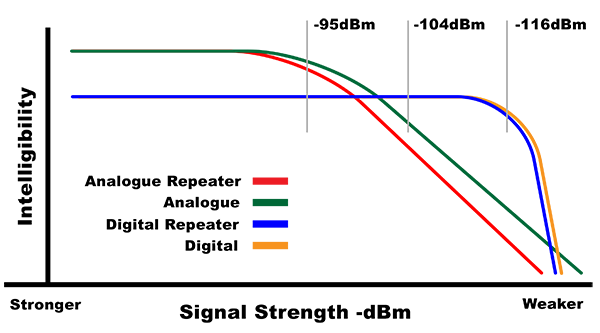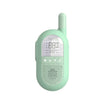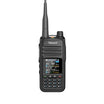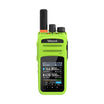DMR digital technology provides better noise rejection and preserves voice quality over a greater range than analogue, especially at the farthest edges of the transmission range. This is because a great deal of effort was put into selecting Forward Error Correction (FEC) and Cyclic Redundancy Check (CRC) coders when developing the standard. With these coders receiving radios detect and automatically correct transmission errors by analysing bits to detect errors. The DMR standard specifies over 14 different coders to be used, each matched to different types of traffic. Through the use of coders and other techniques, digital processing is able to screen out noise and re-construct signals from degraded transmissions. Users can hear much more clearly — increasing the effective range of the radio solution and keeping users responsive to changing situations in the field.

Figure: Range improvement with DMR compared to analogue
There is some debate about which digital system gives the best coverage; a 12.5 kHz or a 6.25 kHz channel based system. Both have advantages and disadvantages. 6.25 kHz based systems are disadvantaged because when you squeeze multiple high power transmissions in 6.25 kHz channels into the spectrum, it is necessary to limit the modulating signal of each transmission quite tightly; in technical terms reduce the signal deviation; so as not to cause interference in the next channel along in the spectrum. This limit on the signal deviation means the receiver is less able to distinguish whether it is being sent a one or a zero when the signal is weak – i.e. at the edge of the system’s range. This, in theory, impacts the coverage of 6.25 kHz systems.
Some regulators will also limit the power of repeaters used in 6.25 kHz FDMA systems to 50% of that available to a 12.5 kHz DMR system, where a user wishes to operate two 6.25 kHz repeaters in a given 12.5 kHz of spectrum. This is carried out to ensure that overall power levels are maintained per unit of spectrum. Such restrictions may also impact range. DMR systems also benefit from superior implementation of Forward Error Correction protocols. FDMA systems do, however, benefit from the fact that with a 6.25 kHz channel there is a lower noise floor than with a wider 12.5 kHz channel.






























